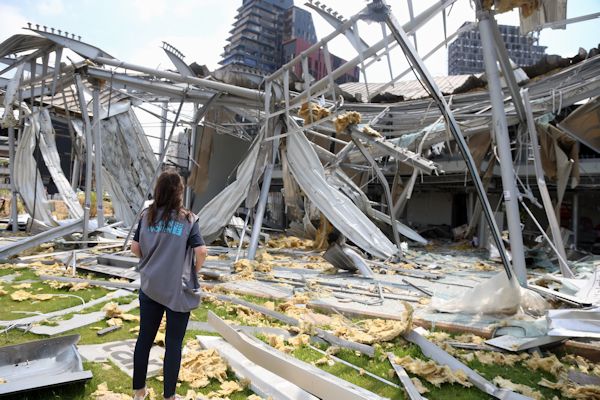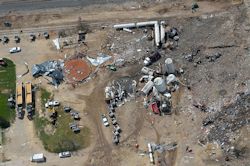SEJournal Online is the digital news magazine of the Society of Environmental Journalists. Learn more about SEJournal Online, including submission, subscription and advertising information.
 |
| A United Nations worker in Beirut's Mar Mikhael neighborhood, at the scene of the August ammonium nitrate blast. Photo: UN Women/Ibrahim Dirani, Flickr Creative Commons. Click to enlarge. |
Backgrounder: Potentially Explosive Fertilizer Could Be Found in Your Community
By Joseph A. Davis
Could the deadly Aug. 4 explosion that devastated Beirut happen here in the United States?
It could. And in fact, it already has.
In Beirut, the blast was caused by thousands of pounds of ammonium nitrate, a commonly used agricultural fertilizer (sometimes also used as an explosive). Apparently, it was a shipload that had been badly stored and neglected for years, right in the port area of central Beirut.
It was also ammonium nitrate that caused the 2013 explosion in West, Tex., which killed 15. The 1995 Oklahoma City bombing that killed 168 was ammonium nitrate as well. Going back even further, the 1947 ship explosion in Texas City that killed 581 people was ammonium nitrate, too.
So, is the United States doing enough to protect people here from ammonium nitrate explosions? It’s a difficult question to answer.
For starters, ammonium nitrate is held in many locations in the United States. According to the Agriculture Department, some 608,000 tons of ammonium nitrate were applied to U.S. fields in 2015.
But it’s often hard to tell exactly where it’s stored — whether on farms, in “seed and feed” retailers in farm communities, sometimes on railroad sidings, sometimes in railcars moving through towns, near mining operations and elsewhere.
USDA statistics seem to show a decline in ammonium nitrate use in the United States over the past two decades. Awareness of ammonium nitrate safety issues has certainly increased since the 9/11 attacks and the West, Texas, accident.
In addition, various regulatory efforts have made it harder for dealers to sell and harder for farmers to buy, pushing them to other nitrogen fertilizers. Perhaps increasing awareness of nitrogen pollution (one cause of the annual “dead zone” in the Gulf of Mexico ) has helped reduce application rates as well. But it’s still used widely.
Regulation? Yes and no
Regulation of ammonium nitrate is a murky and complicated subject. Recent decades saw an epic federal effort to regulate hazardous chemicals — and an epic effort by various industries to resist regulation.
Farmers and fertilizer companies
have opposed controls of
ammonium nitrate on many fronts.
Ammonium nitrate, which is very hazardous in the wrong circumstances, has been part of that regulatory effort. But farmers and fertilizer companies have opposed controls on many fronts.
One of the first federal efforts to deal with hazardous substances generally came after the 1984 Bhopal chemical release, which killed thousands. By 1986, Congress had passed the Emergency Planning and Community Right-to-Know Act, or EPCRA.
With EPCRA, industry averted direct regulation of their operations by conceding to a regime of public information. Idealists hoped that if the public knew about chemical threats to a community, they would pressure the industry to clean up its act.
Sometimes that’s what happened. But over the years, industries worked hard to narrow and block the amount of information actually going to the public. Sadly, ammonium nitrate was not on the list of chemicals regulated under EPCRA anyway. The U.S. Environmental Protection Agency chose to omit it.
In 1990, Congress passed what might have been a tightening of EPCRA reporting, with an amendment to the Clean Air Act that mandated dangerous chemical facilities to have Risk Management Plans, or RMPs.
It then took most of a decade for the EPA to come up with the implementing RMP rule. But in the end, when EPA published the list of chemicals requiring RMPs, ammonium nitrate was again not on the list.
Resistance to EPCRA mounted over the next decade and, in 1999, as concerns over terrorism grew worldwide, Congress drastically limited what the public could know. The Chemical Safety Information, Site Security and Fuels Regulatory Relief Act, or CSISSFRA, restricted public access to the worst-case scenarios in the offsite consequence analyses for certain categories of the most dangerous chemicals.
No, ammonium nitrate was not on that list, either. But CSISSFRA was a big win for the argument that public information about hazards was, as some Republicans put it, “a roadmap for terrorists.”
In wake of terror attack, fertilizer finally covered
Then 9/11 happened and everything got worse. Worry about terrorism became a national obsession and by the next year, in 2002, the Department of Homeland Security, or DHS, was created.
During that general period, a lot of public information (e.g., dam safety info) was blacked out from public disclosure. The chemical industry campaigned to put more of its information under DHS rather than EPA. A substantial federal program to regulate and track ammonium nitrate still did not exist.
By 2006, Congress took another major step when it put into an appropriation bill a fairly obscure provision mandating that DHS issue regulations for chemical facility security. DHS came up with those regs, called the Chemical Facility Anti-Terrorism Standards, or CFATS, in April 2007. They applied to plants handling chemicals on a set list above certain amounts or concentrations.
Ammonium nitrate was on that list. The rule required facilities to report to DHS if they handled quantities of those chemicals (including ammonium nitrate) and protected that information from public disclosure.
 |
| Aerial photo of the West, Texas, explosion site taken several days after the 2013 blast. Photo: WikiMedia Commons. Click to enlarge. |
Those regs came out under the industry-friendly Bush administration. Most of the attention in the CFATS program went to big chemical plants rather than fertilizer.
Then, in 2013, came the West, Texas, explosion. President Obama quickly issued an executive order (EO 13650, 8/1/2013) telling all agencies to coordinate better, to update rules, to share information with state and local agencies, … and to generally pull up their socks. It was meant specifically to address the safety shortcomings that the West fertilizer explosion had revealed.
To make a long story short, there had grown up, beginning even before the Obama administration, an Ammonium Nitrate Security Program under DHS, specifically under the Cybersecurity & Infrastructure Security Agency, or CISA. This program evolved.
At its core was a requirement that producers, sellers and users of ammonium nitrate all had to register with DHS. They then had to be vetted against terrorist watchlists. Without a DHS-issued number, they could not do business.
Complex oversight leaves blind spots
But it was clear, as shown in several reports following the West explosion, that the system wasn’t working. DHS did not really know where all the ammonium nitrate was, nor did it share what it knew with state and local agencies.
The mix of federal, state and local oversight produced blindness and chaos. And the obsessive focus on terrorism as a threat left many other risks unattended to: storage safety, fire prevention, diversion, negligence, and theft and loss, for example.
In 2013, firefighters in West, Texas, had rushed to a fire at the fertilizer warehouse, unaware of the explosion hazard that ultimately killed at least a dozen of them, among other fatalities. It was just the sort of blind spot, or lack of information-sharing, that Obama had hoped to remedy.
Even under EPCRA, this was supposed to take place under a system of State Emergency Response Commissions and Local Emergency Planning Committees. But it hadn’t happened effectively enough. What first responders didn’t know, in this case, killed them.
How journalists can respond
No, the federal government is not about to tell the public — or journalists — what it knows about how much ammonium nitrate is stored where. Much less whether it is stored safely. If it knows at all.
And there is no database where you can look this up — at least not one you have access to. (Ammonium nitrate is not included, for example, in the RMP database, which is somewhat available, thanks to the Houston Chronicle.)
Why would you want to know this unless you were a terrorist?
Well, maybe you sit on a local zoning or planning board, and want to know whether a certain location is appropriate for building a new nursing home. Or maybe you are a school board member, and want to know whether you should approve a certain location for a new elementary school.
Or maybe you are a local news reporter covering zoning or the school board.
In any case, environmental reporters may not have to work very hard to figure this stuff out.
If you live near an agricultural community, go visit your local feed-and-seed retailer. Talk to farmers. Talk to firefighters.
Or go down to your local grain elevator, and check out cars standing on nearby rail sidings. The hopper cars carrying ammonium nitrate will be marked with the UN Number (for identifying hazmats) 1942 or one of several others you can look up here.
And for more on the topic, check out these other SEJournal articles:
- Backgrounder: Breaking the ‘Cycle’ on Chemical Safety Story
- TipSheet: Hazardous Sites Near You? There’s a Database for That!
- Texas Fertilizer Explosion Re-Raises Buried Hazmat Disclosure Issues
Joseph A. Davis is a freelance writer/editor in Washington, D.C. who has been writing about the environment since 1976. He writes SEJournal Online's TipSheet, Reporter's Toolbox and Issue Backgrounder, as well as compiling SEJ's weekday news headlines service EJToday. Davis also directs SEJ's Freedom of Information Project and writes the WatchDog opinion column and WatchDog Alert.
* From the weekly news magazine SEJournal Online, Vol. 5, No. 31. Content from each new issue of SEJournal Online is available to the public via the SEJournal Online main page. Subscribe to the e-newsletter here. And see past issues of the SEJournal archived here.














 Advertisement
Advertisement 



